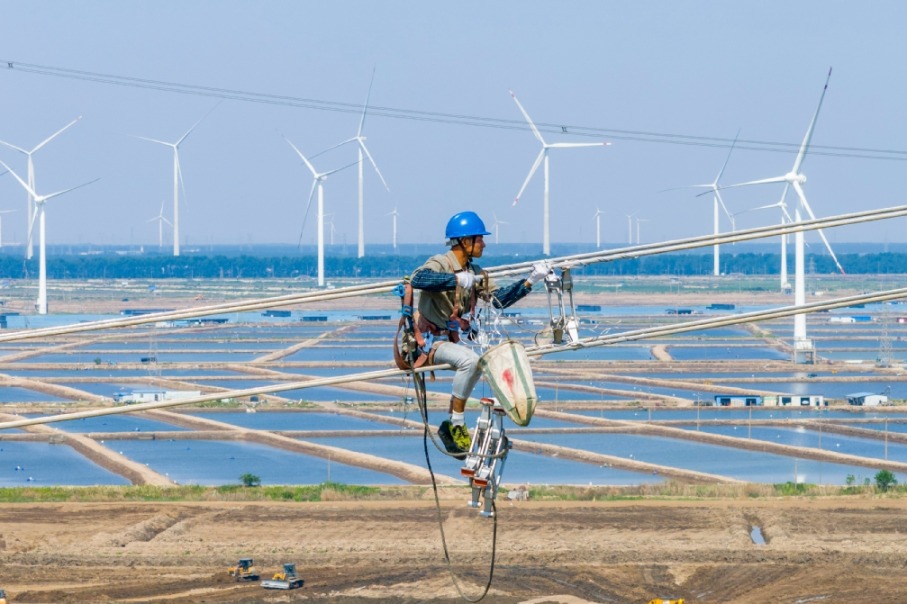Air power

|

Viewers take in a model of the C919 aircraft at an industry exhibition. Edmond Tang / China Daily
|
In 1992, China National Aviation Holding Company teamed up with McDonnel Douglas to make 40 MD-90 airplanes. Over 70 percent of the 150-seat aircraft were developed in China. But the project was terminated after two deliveries, as McDonnel Douglas merged with Boeing.
Conceived in 2007, COMAC wants to produce homegrown jumbo jets and become the third biggest player in the global commercial aircraft industry by 2020.
The Shanghai-based COMAC began operations in 2008 with capital of 19 billion yuan (2.18 billion euros). This included 6 billion yuan from the central government, 5 billion yuan from the Shanghai government and 5 billion yuan from China Aviation Industry Corporation (AVIC), a Chinese consortium of aircraft manufacturers. Steel maker Baosteel, aluminum maker Chinalco and chemicals maker Sinochem also chipped up with equal contributions of 1 billion yuan each.
Demand for commercial aircraft has been growing steadily in the last few years thanks to the growing number of air travelers and rising purchasing power especially in countries like China.
"It is a project of national importance and is in the same league as that of the Three Gorges hydro power and the manned spacecraft project," says Cao.
"It is also the most opportune time for China to make a mark in the aviation sector. This is an era where the Chinese aviation demand is taking off. The country needs more aircraft than before".
AVIC expects air passenger volume in the nation to grow by nearly 8.3 percent every year till 2029.
Global aircraft makers also agree that China is where all the action is. Boeing said last month that Chinese buyers will purchase $480 billion (363 billion euros) worth of aircraft over the next two decades and triple its present fleet size, making it the largest airplane market outside of the US.
Boeing forecasts that the Chinese market will need close to 3,770 jetliners for its domestic routes over the next 20 years. At current prices, that means nearly $400 billion worth of aircraft. Globally, Boeing places the 20-year demand for planes such as the C919, 737 and A230 at nearly 19,500, valued at $1.4 trillion.
Airplane manufacturing and purchases have not always been just commercial or technological decisions. These are also political decisions, says Zou Jianjun, an associate professor at the Civil Aviation Management of Institute of China.
"It is inevitable that China's dependence on imported airplanes will reduce over a period of time."
|

|
Though there has been no knee-jerk reaction from Boeing or Airbus, it is evident that international firms are wary of China's growing aviation prowess, says Cao.
Boeing said it welcomes competition and hopes it would act as a catalyst for innovation. "The C919 is a good thing and there is room for competition," says James Simon, vice-president of commercial-airplane sales at Boeing China. "It makes all of us do our job better and build more efficient aircraft."
"If the product is good it will sell. The airlines will not take delivery and operate an aircraft unless it's competitive," says Laurence Barron, president of Airbus China.
The real challenge for Chinese aircraft makers and their foreign partners is when they start selling their planes outside of China, say analysts.
"Chinese manufacturers will certainly reduce the market share of Boeing and Airbus," says Peter Harbison, executive chairman of Centre for Asia Pacific Aviation. "But it is not going to make a dramatic impact overnight."
The Chinese are not the only players to make rapid strides in the global aviation market. Other countries like Brazil and Russia are also coming out with new aircraft, says Zhou.
Chinese companies will also face problems related to technology transfer when they start growing bigger, says Cao. Airplanes made by COMAC can gain market share in emerging countries where the demand is growing as Chinese firms can offer the best prices, he says.
Today's Top News
- Xi calls for upholding of ethnic unity
- Abuse of 'security' stifles innovation, collaboration
- Beijing warns countries against signing trade deals with US that hurt Chinese interests
- AI shouldn't undermine humanity's progress
- Xi urges villagers in Xizang to uphold ethnic solidarity
- Digital tax sparks breakdown in US-Canada trade talks






























